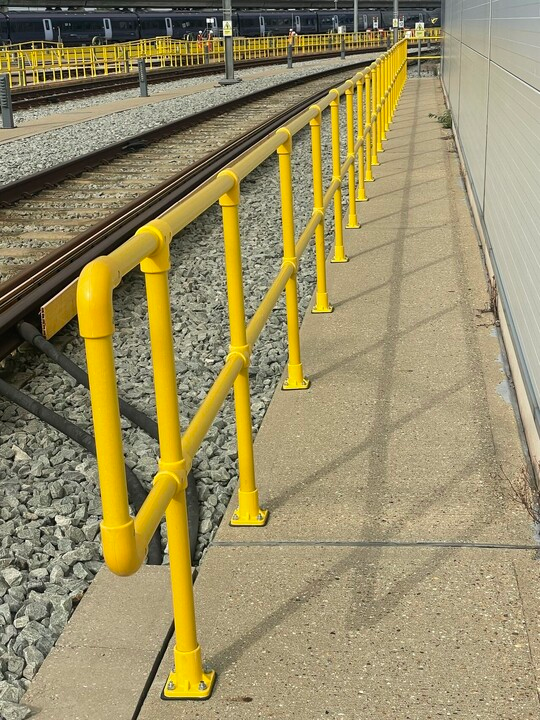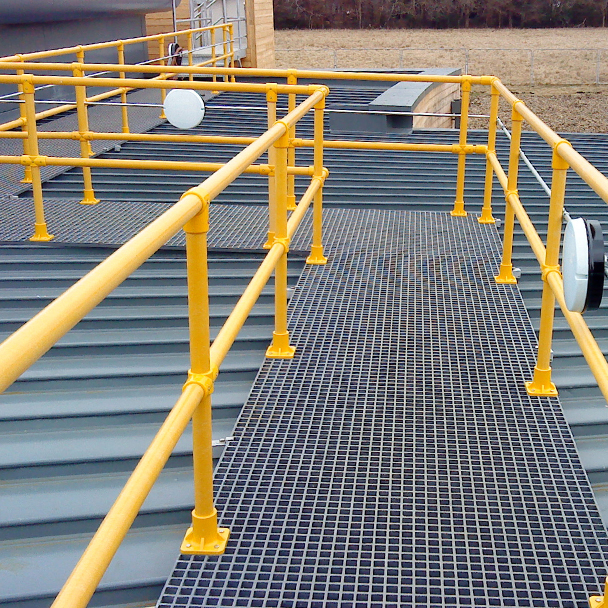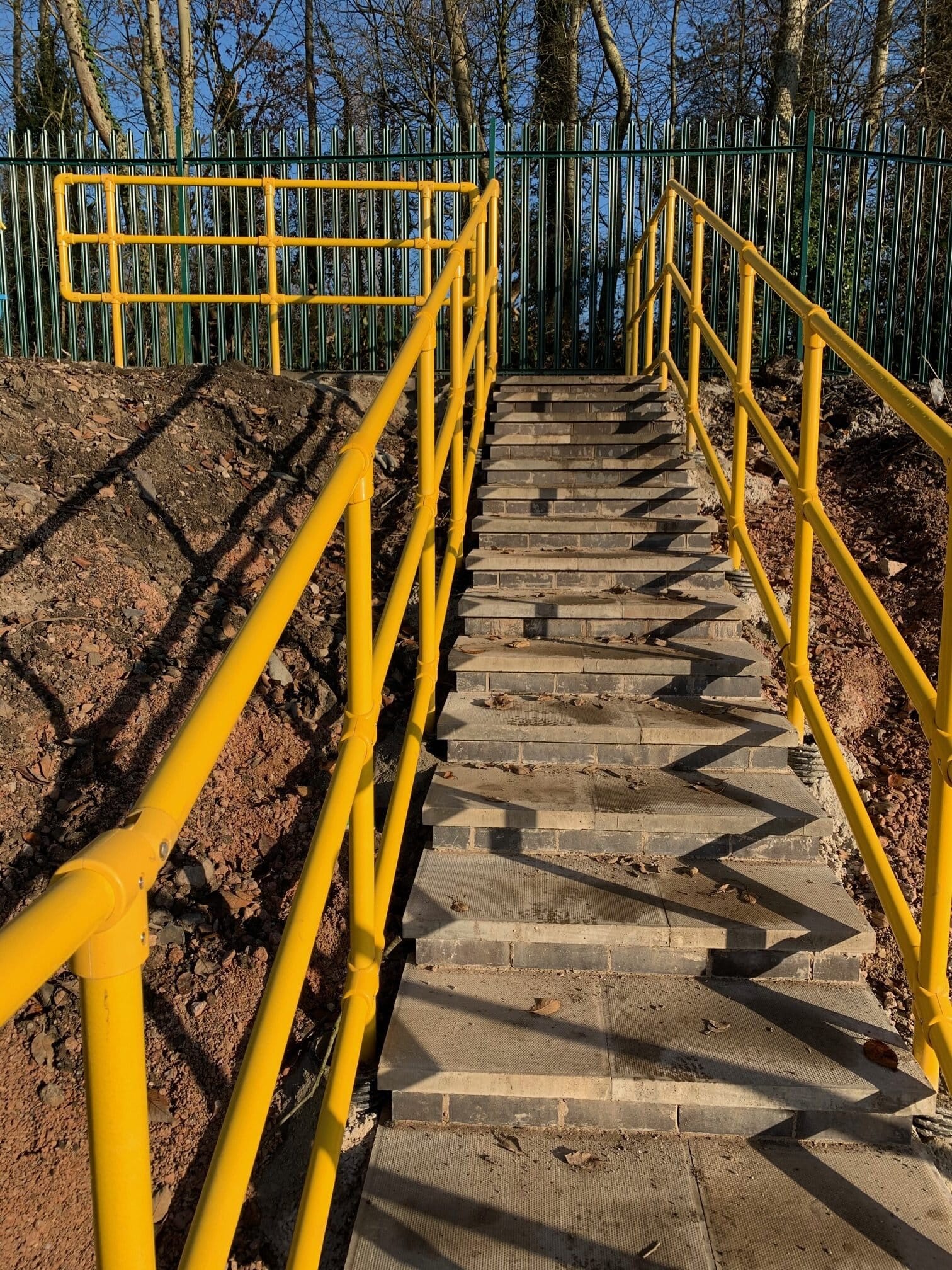FRP (Fiber-Reinforced Plastic) High Load Platform is a structurally enhanced composite platform designed to support heavy loads in industrial, commercial, and marine environments. This platform combines exceptional strength, durability, and corrosion resistance, making it a superior alternative to traditional materials like steel, aluminum, and wood.
제품 성능 소개
This article provides a detailed overview of FRP High Load Platforms, including their physical properties, specifications, advantages, disadvantages, and applications.
1. Physical Properties of FRP High Load Platform
1.1. High Strength and Load Capacity
-
Engineered for Heavy-Duty Applications – Capable of supporting significantly heavier loads compared to standard FRP platforms.
-
Load Ratings: Can handle up to 10,000 kg/m², depending on structural design and support configuration.
-
High Impact Resistance – Designed to absorb shocks and mechanical impacts without permanent deformation.
1.2. Corrosion and Environmental Resistance
-
Excellent Chemical Resistance – Withstands exposure to acids, alkalis, solvents, and saltwater environments.
-
Zero Rusting or Corrosion – Ideal for marine, offshore, and wastewater applications.
-
Moisture and Weatherproof – Suitable for outdoor and high-humidity environments.
1.3. Electrical and Thermal Insulation
-
Non-Conductive Material – Provides excellent electrical insulation, making it safe for power plants, substations, and high-voltage areas.
-
Low Thermal Conductivity – Prevents excessive heat transfer, beneficial in high-temperature environments.
1.4. Fire Resistance
-
Fire-Retardant Options Available – Can be manufactured with fire-resistant resins for added safety.
-
Low Smoke and Toxicity Emissions – Ensures safer use in confined industrial spaces.
2. Specifications and Design Options
2.1. Standard Dimensions and Load Ratings
-
두께: 38mm (1.5") to 50mm (2")
-
Panel Sizes: 1m × 1m, 1.2m × 2.4m, or custom sizes
-
Load Capacities: 5,000 – 10,000 kg/m² depending on design and support spacing
2.2. Types of FRP High Load Platforms
-
Heavy-Duty FRP Grating Platforms – Open-mesh platforms with superior drainage and slip resistance.
-
Solid High Load FRP Platforms – Continuous surface for cleanrooms, factories, and workstations.
-
Modular FRP Platforms – Pre-engineered for quick installation and expansion.
2.3. Material Composition
-
Reinforcement Fibers:
-
E-glass or S-glass fibers – Provides exceptional strength and durability.
-
Carbon Fiber Reinforced FRP – For extreme load-bearing applications.
-
-
Resin Types for Specialized Applications:
-
Polyester Resin – General-purpose use with good chemical resistance.
-
비닐 에스테르 수지 – Enhanced chemical and heat resistance.
-
에폭시 수지 – Superior mechanical strength.
-
페놀수지 – Best for fire resistance and low smoke emission.
-
2.4. Mechanical Properties (Typical Values)
| 재산 | Typical Value |
|---|---|
| 인장강도 | 300-800 MPa |
| 굽힘 강도 | 250-700 MPa |
| 압축 강도 | 300-850 MPa |
| 밀도 | 1.7-2.2 g/cm³ |
| Modulus of Elasticity | 25-45 GPa |
3. Advantages of FRP High Load Platforms
3.1. Superior Strength-to-Weight Ratio
-
Lighter than steel but equally strong.
-
Reduces overall structural weight, making it easier to install.
3.2. Corrosion Resistance for Harsh Environments
-
No rusting, rotting, or degradation over time.
-
Ideal for chemical plants, offshore platforms, and wastewater facilities.
3.3. Electrical and Magnetic Safety
-
Non-Conductive and Non-Magnetic – Essential for electrical substations, telecom sites, and MRI rooms.
3.4. Slip-Resistant and Safe
-
Integrated grit surface or anti-slip coatings for enhanced safety.
-
Reduces the risk of slip-and-fall accidents in wet and industrial areas.
3.5. Low Maintenance and Long Lifespan
-
No need for painting, sealing, or chemical treatments.
-
Does not warp, crack, or degrade like wood or metal.
3.6. Customizable and Versatile
-
Easily cut, shaped, and drilled for installation.
-
Available in different colors and finishes for functional and aesthetic purposes.
4. Disadvantages of FRP High Load Platforms
4.1. Higher Initial Cost
-
More expensive than standard FRP platforms or traditional steel alternatives.
-
However, long-term savings in maintenance and durability offset initial costs.
4.2. Lower Stiffness Compared to Steel
-
Requires additional structural supports for high-load applications.
-
May deflect slightly under extreme weight, unlike rigid steel structures.
4.3. UV Sensitivity
-
Extended exposure to direct sunlight may cause surface wear.
-
Requires UV-resistant coatings for outdoor applications.
4.4. Limited Heat Resistance
-
FRP begins to weaken above 200°C, while steel withstands much higher temperatures.
-
Fire-resistant options are available but at higher costs.
4.5. Recycling Challenges
-
Difficult to recycle due to composite nature.
-
Not as environmentally friendly as steel, which can be 100% recycled.
5. Applications of FRP High Load Platforms
5.1. Heavy-Duty Industrial Applications
-
Oil Refineries and Petrochemical Plants – Withstands chemical exposure and extreme weather.
-
Steel Mills and Foundries – Non-conductive and resistant to heavy loads and vibrations.
-
폐수 처리 시설 – Long-lasting, moisture and corrosion-resistant solution.
5.2. Marine and Offshore Structures
-
Shipyards and Docks – Resists saltwater corrosion.
-
Oil Rigs and Floating Platforms – High load capacity with minimal maintenance.
5.3. Public Infrastructure and Construction
-
Bridges, Elevated Walkways, and Stairs – High durability, lightweight, and maintenance-free.
-
Transit and Railway Stations – Non-slip and fire-resistant safety platforms.
5.4. Electrical and Telecommunications
-
Substations and Power Plants – Non-conductive, eliminating electrical hazards.
-
Telecom Towers and Data Centers – Lightweight, corrosion-resistant alternative to steel platforms.
5.5. Food and Pharmaceutical Industries
-
Sanitary and Easy-to-Clean – Used in cleanrooms, food processing facilities, and medical labs.
-
Hygienic, Non-Toxic Surface – Prevents bacterial growth.
6. Conclusion
그만큼 FRP High Load Platform is an advanced composite solution that offers exceptional strength, corrosion resistance, and low maintenance ~을 위한 industrial, marine, and heavy-duty applications.
FRP High Load Platform
시리즈 :
주요제품 >애플리케이션
Industrial Plants and Chemical Factories Offshore Platforms and Marine Environments Water and Wastewater Treatment Facilities Power Plants and Substations Public Transport Stations and Pedestrian Bridges Construction Sites and Warehouses
상표명 :
TF컴포지트
상품명 :
FRP High Load Platform
재료 :
유리 섬유
색상 :
Yellow,Other
자주하는 질문
질문 :
How much load can an FRP High Load Platform support?
ㅏ :
The load capacity depends on the design, thickness, and support structure. Standard FRP High Load Platforms can support up to 10,000 kg/m². Specific load ratings should be verified based on project requirements.
질문 :
What types of FRP High Load Platforms are available?
ㅏ :
Heavy-Duty Grating Platforms – Open-mesh for slip resistance and drainage. Solid-Surface Platforms – Continuous flooring for clean environments. Custom Modular Platforms – Pre-fabricated for easy installation and expansion.
질문 :
What industries use FRP High Load Platforms?
ㅏ :
FRP High Load Platforms are commonly used in: Oil & Gas Industry – Offshore rigs, refineries, and chemical plants. Marine & Shipyards – Docks, decks, and floating platforms. Wastewater Treatment Plants – Corrosion-resistant walkways and platforms. Construction & Infrastructure – Bridges, railway stations, and industrial floors. Power Plants & Substations – Non-conductive safety platforms.
질문 :
Can FRP High Load Platforms be used outdoors?
ㅏ :
Yes! FRP platforms are UV-resistant and weatherproof, making them ideal for outdoor applications such as bridges, piers, and marine structures. However, UV-protective coatings may be recommended for long-term exposure.
질문 :
Are FRP High Load Platforms fire-resistant?
ㅏ :
Standard FRP has some fire resistance, but fire-retardant resins (e.g., phenolic or vinyl ester resins) can be used to enhance fire safety. Fire ratings depend on industry and regulatory requirements.
질문 :
How long does an FRP High Load Platform last?
ㅏ :
The lifespan of FRP platforms is 25–50 years, depending on environmental exposure and load conditions. They require minimal maintenance, unlike steel or wood platforms.
기타 관련 제품














